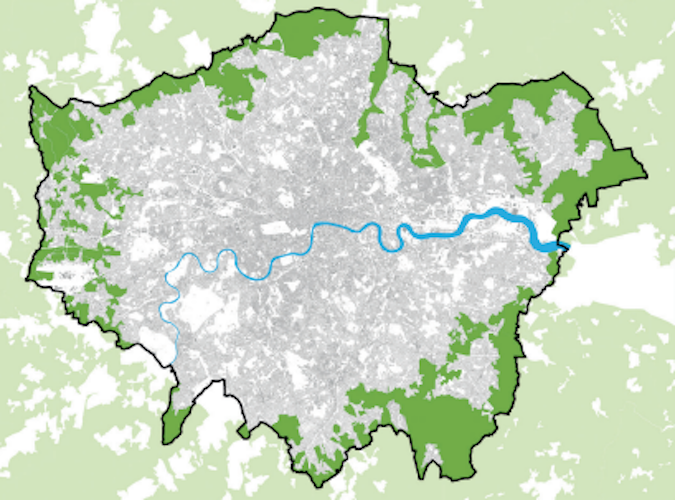Could the row between the government and Sadiq Khan over the detail of the Labour Mayor’s London Plan, the development blueprint for the capital, be a game-changer for the forthcoming City Hall election? Michael Gove certainly seemed to think it was worth timing his latest intervention on the Plan to coincide with the launch of Khan’s re-election campaign.
While Khan was pledging to deliver 40,000 more council homes, the Conservative minister was ordering him to review parts of the Plan, which he claimed were contributing to “chronic under-delivery” of new housing. Policies for protecting industrial land and regenerating “Opportunity Areas” were thwarting development, he said.
Gove’s review call came soon after his previous assault on the London Plan, a probe by a team of experts he had appointed into getting more homes on previously-developed “brownfield” land. It seems that initiative failed to hit its target in the way the minister wanted, making generalised recommendations only. But with a six-month deadline and a wider City Hall review of the Plan underway in any event, this latest move isn’t going to shift the dial on housing delivery any time soon either.
Its timing therefore gives weight to Khan’s verdict that it is more of an election stunt than a serious attempt to unpick a Plan that hasn’t stopped him meeting Whitehall requirements for 116,000 affordable homes to be started between 2016 and 2023 – including, he argues, the largest number of council homes since the 1970s – while government performance outside London has fallen short. There’s some irony too in Gove singling out the London Plan for criticism as his wider planning policy changes see councils across the country cutting back on development.
But the Plan, and how mayoral candidates might change it, deserves attention. It is perhaps the main weapon in a Mayor’s arsenal when it comes to influencing what actually gets built in the capital, and where. The boroughs’ own development plans must be in conformity with it, and its policies must be taken into account when decisions are taken by boroughs on individual planning applications.
Khan’s 2021 Plan, like those of his predecessors, sought to respond to the continued increase in London’s population and encourage growth and – not growth at any costs, but “good growth”, defined as socially and economically inclusive and environmentally sustainable, and “rebalancing” development towards “more genuinely affordable homes for working Londoners to buy and rent”.
It’s been groundbreaking, he told the London Assembly earlier this month; embedding environmental policies, “raising the bar” on housing design quality, doubling affordable housing quotas on major schemes to 41 per cent compared with 22 per cent when he came to power in 2016, preserving the Green Belt and protecting vital industrial land.
London is still failing to deliver enough homes though, as Khan acknowledged. “While many of the reasons for this are beyond the Mayor’s control, it will be important for any London Plan review to look again at how housing delivery and particularly affordable housing provision can be increased,” he said.
So what needs to change? Gove’s expert panel reported “persuasive evidence” that the current Plan’s plethora of requirements, on design, on safeguarding industrial land and not least on requiring 35 per cent of new homes to be affordable, was frustrating brownfield development. Those “good growth” policies, it said, were effectively costing would-be developers too much in current economic circumstances.
On cue, Tory mayoral candidate Susan Hall is pledging to “reopen” the London Plan, to remove “unnecessary red tape” and get more high density but low-rise family homes built on brownfield sites, “homes that people want to live in, which do not disrupt existing communities or the Green Belt”. And Liberal Democrat contender Rob Blackie promises to be a “YIMBY champion”.
The London Plan is due a refresh whoever wins, and more details will no doubt come as manifestos are unveiled. But big questions remain for the candidates. On brownfield, for example, expert analysis is now pretty much unanimous, that there’s simply not enough of it.
And the “opportunity areas” Gove is targeting include precisely those brownfield sites which present the biggest challenges. Developing them is complex and costly, with affordable housing quotas at risk if the financial numbers are to add up. Will those “good growth” standards be sacrificed and affordable quotas cut back? How else will the candidates square that circle?
The capital’s growing population needs its industrial sites too, being important for the city’s economy. After two decades of depletion, London “cannot afford to lose any more”, a high level commission convened by the Centre for London think tank concluded recently. Will the candidates nevertheless advocate moving that economic activity – and the jobs it provides – out of the city?
Above all, perhaps, can we expect some acknowledgement of what Matthew Spry, London director of planning and development consultancy Lichfields, concluded last month was the “inescapable conclusion” from these debates, that “in the real world our housing needs can only be met through a mix of brownfield and greenfield land”? Will any mayoral candidate grasp that Green Belt nettle?
X/Twitter: Charles Wright and OnLondon. Support OnLondon.co.uk and its writers for just £5 a month or £50 a year and get things for your money too. Details HERE.

